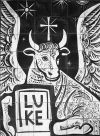
The Gospel of Luke
The Calming of the Sea and the Calming of the Demoniac: Lk 8,22-39
"Calming" may be a good word to link these two incidents. It is common to refer to the first one as the calming of the sea (8,22-25). It also seems an appropriate word for the man with the demons, he was living in an uncontrollable storm (8,29) but he is restored to calm by Jesus (8,35). Luke more than the other two evangelists stresses the strength of both storms: the disciples "were in danger", 8,23, and elaborate description of the man's condition in 8,27 and 8,29 are both additions by Luke.
The two stories are also linked by the demons. That's clear in the second story. In the calming of the storm we have Jesus rebuking the wind and the waves, a word we have seen several times for an exorcism, Mary Magdelene in 8,2 being an example.
The calming of the sea: Lk 8,22-25
The background for this story is that the ancients saw the sea as the place of chaos, the place where humans are helpless (Ps 107). Jonah like Jesus was asleep during the storm (Jonah 1,5). And later on, St Paul would be involved in a shipwreck (Acts 27). Recalling the crossing of the Red Sea in Exodus is a reminder that there is a new saving power present. The Red Sea is rebuked (Ps 106,9).
Luke makes a break with the preceeding scene (8,22). He omits Mark's little detail of Jesus asleep with his head on a cushion. He stresses the danger (8,23) and the raging of the water (8,24).
All three evangelists speak of Jesus rebuking the wind, to which Luke adds the waves as well. Especially for Luke, "rebuke" is as we have noted a word of exorcism.
The signifcant change in Luke is that Jesus says to the disciples not "have you faith?" (Mk 4,40) but "where is your faith?" (8,25). Luke also notes that it is Jesus who commands the wind and the sea (8,25).
An episode like this can be read against the background of the early Church as a call to faith and perseverance when surrounded by so much danger.
Back now to the main page and on to the second calming.
The Calming of the Demoniac: Lk 8,26-39
The country of the Gerasenes is not in Galilee. This episode conflicts with Luke's plan of keeping Jesus in Galilee until he is ready to depart for Jerusalem (9,51). Luke therefore takes care to mention Galilee (8,26) even though the man healed would have been a Gentile. As a Gentile is involved, this healing would have had a special resonance for Luke's community of Gentile Christians. We have here a story of transformation through the power of Jesus.
Compared with Mark, we noted above how Luke stresses in verses 27 and 29 the outside nature of the man: he is out of the city, he has no clothes, he is not in a house, he was driven by the devil into the desert. He was possessed by devils.
The dramatic encounter with Jesus follows (8,28-33). The comment about the abyss (Apoc 17,8) is a bit strange as that is the abode of the demons. They end up in the lake anyway. That's a contrast with the previous scene where the disciples were saved from the lake.
What is clear though in this episode is the power and authority of Jesus which is not denied by those demons.
Through the power of Jesus, the man is transformed: he becomes clothed and in his right mind (8,35), he was able to return to his house and live in the city (8,39).
Almost like a prototype Christian, he is told by Jesus to proclaim the great things God had done for him - but actually he proclaims the great things Jesus had done for him (8,39)
Back now to the main page
